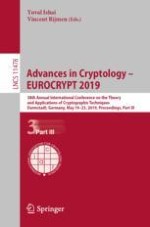2019 | OriginalPaper | Buchkapitel
Distributional Collision Resistance Beyond One-Way Functions
verfasst von : Nir Bitansky, Iftach Haitner, Ilan Komargodski, Eylon Yogev
Erschienen in: Advances in Cryptology – EUROCRYPT 2019
Aktivieren Sie unsere intelligente Suche, um passende Fachinhalte oder Patente zu finden.
Wählen Sie Textabschnitte aus um mit Künstlicher Intelligenz passenden Patente zu finden. powered by
Markieren Sie Textabschnitte, um KI-gestützt weitere passende Inhalte zu finden. powered by
